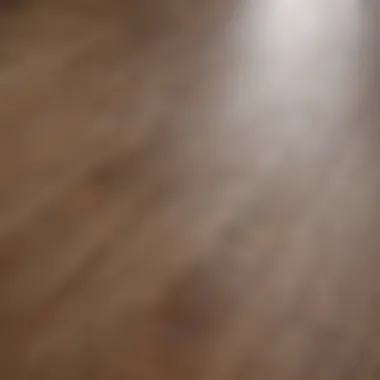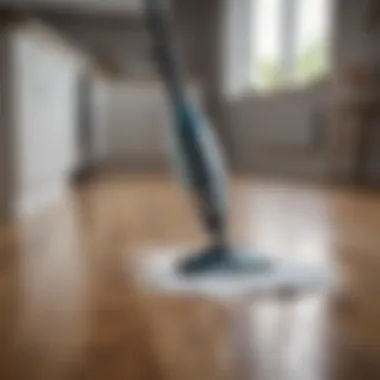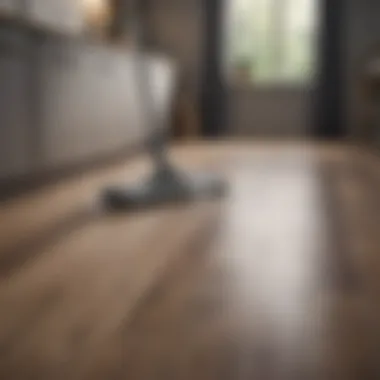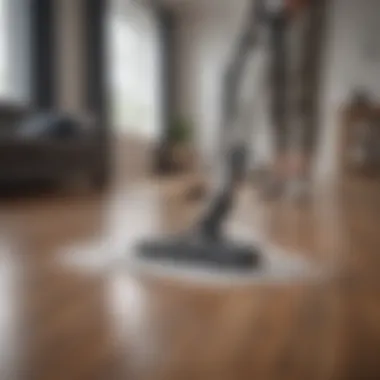Is a Steam Mop Safe for Cleaning Laminate Floors?


Intro
In today's world of home maintenance, many homeowners seek efficient cleaning solutions. As laminate floors grow in popularity thanks to their versatility and aesthetic appeal, questions arise regarding the best cleaning practices. One such query is whether steam mops can be safely used on laminate surfaces. Understanding the composition of laminate floors, alongside the mechanics of steam mops, is essential for making an informed decision.
Laminate flooring typically consists of several layers, including a wear layer, design layer, and high-density fiberboard core. This construction can make it susceptible to moisture damage, which raises concerns about the use of steam mops. Steam mops deliver high-temperature steam that can penetrate surfaces; however, this can lead to potential problems when used on laminate flooring.
The aim of this article is to explore both the advantages and disadvantages of steam cleaning for laminate floors. Additionally, we will provide guidance on suitable methods and alternative products that can help maintain the beauty and integrity of your laminate flooring.
Home Features
Cleaning methods can significantly influence the longevity of home features. Understanding how different substances interact with your laminate can prevent costly repairs and replacements. While laminate floors are engineered with durability in mind, it is wise to approach cleaning with caution.
Considerations for Flooring Maintenance
When assessing the maintenance of laminate floors, it is important to focus on:
- Humidity Levels: Excess moisture can warp laminate boards.
- Cleaning Products: Using appropriate cleaners that won't leave residues is crucial.
- Cleaning Tools: Opting for tools that align with the floor's design can help preserve its finish.
Opting for a steam mop may seem like a convenient choice, but one must consider the potential effects of both heat and moisture on laminate.
Understanding Steam Mops
Steam mops are popular cleaning tools due to their efficiency. They typically operate by heating water to produce steam, which lifts dirt and grime from surfaces. However, the interaction between steam and laminate can be a double-edged sword.
Benefits of Steam Mops
- Deep Cleaning: They can effectively clean and sanitize surfaces.
- Chemical-Free: Many steam mops rely solely on water, making them a greener choice.
Drawbacks of Steam Mops on Laminate Floors
- Moisture Issues: The heat and steam can seep into seams, causing them to swell or separate.
- Heat Sensitivity: Excessive heat can dull or damage the floor's finish.
Given these factors, caution must be exercised when considering steam mops for laminate floors.
"Using steam mops on laminate can lead to irreversible damage; it's essential to follow manufacturer's recommendations."
Alternatives to Steam Mops
For maintaining laminate flooring, consider alternative cleaning methods:
- Dry Mopping: Use a microfiber dry mop to gather dust and debris.
- Damp Mopping: A barely damp cloth with a gentle cleaner can effectively clean without excess moisture.
- Regular Sweeping: Keep floors free from grit that can scratch surfaces.
Understanding the best practices for cleaning laminate floors will help enhance their lifespan while keeping them looking great.
Intro
The cleaning method used for laminate floors is important for maintaining their appearance and longevity. Laminate floors combine aesthetic appeal with practical advantages, providing a cost-effective alternative to hardwood. However, using inappropriate cleaning tools can cause severe damage. This article delves into the suitability of steam mops for cleaning laminate surfaces, outlining the key elements that homeowners should consider.


Understanding how laminate floors are composed helps in assessing the implications of steam cleaning. It is crucial to balance convenience and the risk of damage. While steam mops can excel in removing dirt and grime, the high moisture levels they produce may not be suitable for laminate flooring materials.
The implications of cleaning with steam equipment can vary. Knowing when to choose alternative cleaning methods is essential for the care of laminate floors. This article will explore both the benefits and potential drawbacks of steam mops. By the end, readers should have a well-rounded understanding of if steam mops suit their cleaning needs for laminate flooring.
Understanding Laminate Flooring
Understanding laminate flooring is fundamental when determining if steam mops are suitable for maintaining its surfaces. This knowledge not only helps in decision-making but also ensures the longevity and appearance of laminate floors. Laminate flooring has gained popularity due to its aesthetic appeal and cost effectiveness. However, it comes with specific requirements for cleaning and maintenance, which are critical to appreciate.
Composition of Laminate Floors
Laminate flooring consists of several layers, designed to mimic the appearance of natural wood, stone, or other materials. The core layer, typically made from high-density fiberboard, provides strength and stability. Above the core layer is a decorative photographic layer, which offers the visual style of the floor. Finally, a protective wear layer shields the floors from scratches, stains, and wear. Understanding these components is crucial, as they impact how laminate floors respond to different cleaning methods.
Durability and Maintenance Needs
Laminate floors are known for their durability. However, they can be sensitive to excessive moisture. Unlike hardwood, laminate does not absorb water well. Regular cleaning is necessary to maintain their appearance, yet the methods used must be gentle to avoid damage. The maintenance needs of laminate flooring generally include sweeping, vacuuming, and the occasional damp mopping. Too much water or harsh cleaning solutions can lead to delamination or other serious issues.
Common Cleaning Challenges
Cleaning laminate flooring presents its own set of challenges. One of the significant difficulties is the risk of moisture damage. Since laminate is not waterproof, using too much moisture can cause the edges to swell, leading to costly repairs. Another challenge is dealing with dirt and grime that can accumulate in the seams of laminate planks. Choosing the incorrect cleaning tools, such as abrasive scrubbers or excessive water, can worsen these cleaning efforts.
"It is essential to use the right tools and methods when maintaining laminate floors to preserve their beauty and longevity."
Some common issues people face include streaks from improper cleaners, scratches from using the wrong scrub tools, and a build-up of residue that can dull the surface. Understanding these issues is vital for anyone looking to keep their laminate flooring in optimal condition.
Steam Mops Explained
Understanding how steam mops function is crucial for evaluating their suitability for laminate floors. Steam mops offer a unique cleaning method that utilizes steam to sanitize surfaces. This technique can be especially appealing to homeowners looking for an efficient way to maintain their flooring. By getting familiar with the workings of steam mops, one can make informed decisions regarding their application on laminate.
How Steam Mops Work
Steam mops operate by converting water into steam through a heating element. This steam is then released through a microfiber pad, which lightly dampens the surface being cleaned. The process not only cleans but also disinfects, as the high temperature of the steam effectively kills bacteria. This method allows for a chemical-free cleaning option, which is particularly beneficial for individuals sensitive to traditional cleaning agents.
Regular use can keep laminate floors looking pristine, as steam mops excel in removing dirt and grime embedded in surface crevices. However, the steam’s moisture must be carefully controlled, especially for laminate floors that are more sensitive to water exposure than other flooring types.
Types of Steam Mops
Steam mops come in various styles, each designed to cater to different user needs and preferences. Understanding these types will help in selecting the ideal steam mop for laminate flooring.
Traditional Steam Mops
Traditional steam mops are characterized by their straightforward design. They typically feature a water reservoir, a heating element, and a mop head that attaches via a Velcro system. This simplicity makes them a favored option among many users.
Their primary function is effective cleaning without utilizing harmful chemicals. The continuous steam output ensures that users can cover large areas in a short amount of time. Nonetheless, caution is needed. The potential for excess moisture exists, which could pose risks to laminate flooring and lead to damage if not monitored.
Cordless Steam Mops
Cordless steam mops offer enhanced mobility compared to their traditional counterparts. They run on rechargeable batteries, eliminating the need for a power cord. This feature is appealing for those with larger homes or spaces that require more freedom of movement.


The main advantage is the ease of use and accessibility to hard-to-reach areas. However, battery life can be a limitation. If the mop runs out of charge mid-cleaning, this could result in an unfinished area of cleaning that may require time to re-charge before completion.
Steam Mops with Attachments
Steam mops equipped with attachments increase their versatility. These models often come with additional tools like scrub brushes, upholstery attachments, or steam jets for targeted cleaning. This multi-functionality is beneficial for homeowners looking to clean a variety of surfaces.
Having these attachments allows for thorough cleaning in specific areas that may require more than just steam cleaning on the floor. However, the complexity of operating such mops can pose challenges for some users. A clearer understanding of how to utilize each attachment is necessary to avoid mishaps during the cleaning process.
Compatibility of Steam Mops with Laminate Floors
Understanding the compatibility of steam mops with laminate floors is crucial for homeowners and cleaning enthusiasts. Laminate flooring, known for its aesthetic appeal and durability, requires specific care to maintain its appearance and longevity. Using an inappropriate cleaning method could lead to irreversible damage. Therefore, it is essential to weigh the benefits and considerations of using steam mops on these surfaces.
Manufacturer Guidelines
Manufacturers often provide clear instructions regarding the use of steam mops on laminate floors. Some brands explicitly state whether steam cleaning is suitable for their laminate products. Reading these guidelines is important as it helps to prevent damage that may void warranties. If a manufacturer advises against steam mops, it is typically for reasons concerning excess moisture exposure. Always verify compatibility before using steam cleaning.
Potential Risks of Using Steam Mops
Moisture Damage
Moisture damage is a significant concern when using steam mops on laminate floors. Laminate is made from layers of materials that, when exposed to excess moisture, might swell. This swelling can lead to visible damage and a shorter lifespan for the flooring. The nature of hotspots created by steam can also contribute to moisture build-up in certain areas, intensifying the risk. With laminate flooring, it is crucial to keep water exposure as minimal as possible. The prevention of moisture-related damage emphasizes the need for careful cleaning techniques.
Warping
Warping occurs when laminate flooring absorbs too much moisture, causing it to deform. This process not only alters the floor's appearance but also affects its structural integrity over time. Warping is a difficult issue to reverse, often requiring floor replacement. Laminate floors may warp from prolonged exposure to steam, especially if they are not designed to handle high humidity. Hence, understanding the risk of warping is vital for maintaining the beauty and functionality of laminate surfaces.
Finish Concerns
The finish of laminate flooring can also be compromised by inappropriate cleaning methods. Steam mops produce high heat, which may degrade the protective coating of the laminate. A less effective finish can lead to scratches, dullness, and an overall unattractive floor. If the finish wears away, it could result in further damage due to reduced protection against moisture and dirt. A proper approach to cleaning is necessary to preserve the floor's finish and prevent premature wear.
When Steam Mops May Be Acceptable
In certain situations, steam mops can be acceptable for cleaning laminate floors. If the steam mop has adjustable settings that allow for lower steam output or if a homeowner opts to use it in a well-ventilated area with sufficient drying time, it may minimize the risks associated with moisture. However, the general consensus remains cautious. Always consider the manufacturer's guidelines and weigh the condition of the flooring before proceeding with steam cleaning.
Best Practices for Cleaning Laminate Floors
Cleaning laminate floors requires careful consideration to maintain their appearance and longevity. These surfaces can be sensitive to excessive moisture and harsh chemicals. Therefore, choosing the right cleaning methods is essential. This section explores several best practices for cleaning laminate floors, focusing on alternative cleaning methods and proper techniques if steam mops are selected for use. By following these best practices, homeowners can effectively preserve the integrity of their laminate flooring while ensuring it remains visually appealing.
Alternative Cleaning Methods
Microfiber Mops
Microfiber mops are highly regarded for their effectiveness in both dry and wet cleaning applications. They feature fibers that are finer than human hair, providing superior dirt and dust trapping capabilities. This characteristic makes microfiber mops a popular choice for laminate flooring, as they do not retain excess water, which can lead to damage like warping or bubbling.
The unique feature of microfiber mops is their ability to pick up debris without the need for harsh cleaning solutions. This attribute is advantageous for laminate floors, which can be susceptible to chemicals and abrasive materials. By using a microfiber mop, users can achieve a thorough clean while helping to maintain the flooring’s finish.
However, it is important to wash microfiber pads regularly to avoid the build-up of grime and dirt. Failure to do so may lead to ineffective cleaning. Often, microfiber mops can be reused multiple times before needing replacement, which adds to their overall cost-effectiveness and eco-friendliness.


Dry Mopping Techniques
Dry mopping is another effective method for maintaining laminate floors. It primarily involves the use of a soft cloth or a microfiber mop to effectively lift dust and debris without introducing moisture. This technique is beneficial because it minimizes the risk of damage that can result from wet cleaning methods.
The key characteristic of dry mopping is its simplicity. Homeowners can perform this task without special equipment, making it an accessible option for routine care. A unique feature of dry mopping is that it can be done frequently, ensuring that dust and allergens do not accumulate over time.
Although this method does not provide deep cleaning, it helps in preventing scratches and maintains the finish of the laminate floor. Thus, while dry mopping might not replace the need for occasional damp cleaning, it is a beneficial practice for everyday maintenance.
Gentle Cleaning Solutions
Using gentle cleaning solutions is crucial when cleaning laminate floors. These solutions are often pH-balanced, ensuring they clean effectively without causing damage to the floor's finish. Many homeowners prefer to use a mixture of vinegar and water, which acts as a natural cleaner that can tackle tough stains while remaining safe for laminate surfaces.
The key characteristic of gentle cleaning solutions is their non-abrasiveness. This quality makes them suitable for regular cleaning tasks, allowing homeowners to keep their floors looking pristine without the risk of causing wear and tear. A unique aspect of using such solutions is that they can often be made at home, reducing costs while being environmentally friendly.
One disadvantage to consider is that some gentle cleaners may not excel in heavy-duty cleaning situations. For stubborn stains, it might be necessary to use a more robust cleaning method, but this should always be approached with caution to avoid harming the laminate.
Proper Techniques for Using Steam Mops (if chosen)
If homeowners opt to use steam mops for their laminate floors, it is vital to understand the proper techniques for their use. Incorrect settings or methods can lead to irreversible damage, so handlers should be informed about key factors such as temperature settings, steam duration, and water type used.
Temperature Settings
Temperature settings in steam mops are critical. Using the right temperature when cleaning laminate can mean the difference between effective sanitation and damaging your floors. Most steam mops have adjustable settings. For laminate, it’s crucial to use lower heat levels to avoid potential warping or melting of the floor's surface.
The unique feature of controlling temperature settings is that it allows the user to customize the cleaning experience based on the floor's requirements. While steam can eliminate bacteria and grime, excessive heat may lead to undesirable changes in the laminate material. Therefore, understanding how to operate the temperature function properly is an advantage when using steam mops.
Steam Duration
Steam duration refers to how long the steam is applied during the cleaning process. When using steam mops on laminate floors, it is advisable to keep the duration short. Extended contact with steam can saturate the flooring material, leading to moisture damage.
The key characteristic here is effectiveness versus safety. Short bursts of steam can clean effectively while minimizing risks associated with extended exposure. Homeowners should aim to clean in sections, allowing time for the moisture to evaporate before moving to the next area. This method enhances safety and reduces the chance of damaging the floor.
Using Distilled Water
Using distilled water in steam mops presents several benefits. Regular tap water can contain minerals that may lead to build-up in the mop and potentially affect performance. By opting for distilled water, users can ensure that the steam mop operates efficiently and does not leave residues on the floor after cleaning.
An advantage of distilled water is that it prolongs the life of the steam mop by preventing mineral deposits from forming. Additionally, it minimizes the risk of any unknown chemicals or additives affecting laminate floors. Though distilled water may entail a small additional cost, its benefits for cleaning effectiveness and equipment longevity often outweigh the expense.
By integrating these best practices into the routine cleaning of laminate floors, homeowners can achieve a balance between cleanliness and care. Whether choosing alternative cleaning methods or using steam mops properly, following these guidelines helps sustain the elegance of laminate surfaces.
Finale
In addressing the compatibility of steam mops with laminate flooring, several critical points merit consideration. This discussion brings together essential elements related to cleaning methods, potential risks, and maintenance practices that are uniquely suited to laminate surfaces.
First, it is vital to acknowledge the inherent qualities of laminate flooring. Though these surfaces are durable and user-friendly, they can be susceptible to moisture and heat. Thus, understanding how steam mops function becomes crucial. They deliver hot steam that can penetrate surfaces quickly, and while that is beneficial for certain materials, laminate floors often suffer when exposed to excessive humidity.
Furthermore, the potential risks linked to using steam mops cannot be overlooked. Moisture damage stands out as a primary concern. If the laminate absorbs too much moisture, warping can result, undermining the floor’s integrity. The finish on laminate flooring, which is engineered for durability, may also be compromised if steam cleaning is performed improperly.
In addition, best practices for maintaining laminate floors are clearly outlined. Homeowners should consider opting for alternative cleaning methods, such as microfiber mopping or gentle cleaning solutions. These alternatives provide effective cleaning without the potential hazards associated with steam mops.
"The choice to use steam mops on laminate flooring isn't merely about convenience; it's about preserving the longevity and appearance of your investment."
Lastly, for those who still lean towards using steam mops, proper techniques, such as careful temperature settings and choosing distilled water, can mitigate some risks. Readers are encouraged to apply this knowledge thoughtfully to achieve a harmonious balance between cleaning efficiency and flooring integrity.
In summary, while steam mops may present some advantages, their usage on laminate floors necessitates caution. By understanding the characteristics of both the cleaning methods and the flooring material, homeowners can make informed decisions that protect their laminate surfaces.



